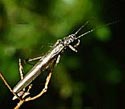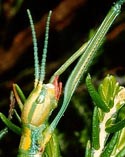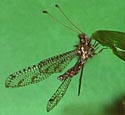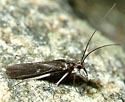|
Insecta (insects)
[= Ectognatha]
Life
> Eukaryotes >
Opisthokonta >
Metazoa (animals) > Bilateria > Ecdysozoa >
Panarthropoda > Tritocerebra > Arthopoda > Mandibulata >
Atelocerata > Panhexapoda >
Hexapoda
Insects are distinguished from other members of the
phylum Arthropoda by having six legs, not
eight (e.g. spiders) or more (e.g.
crustaceans, millipedes and centipedes). They are the most
diverse group of organisms on earth and have a huge impact on our
daily lives through the food they supply (e.g. honey from honeybees),
the food they destroy (agricultural and stored product pests), the
people they kill through spreading diseases, and the integral part
they play in the ecology of terrestrial ecosystems.
Classification
Based mainly on Tree of Life. A '#' before the name
indicates an extinct fossil taxon.
|
Archaeognatha
Elongate, hump-backed insects with a long median caudal filament protruding
from the end of the abdomen, with two lateral cerci that are oriented in the
same axis as the body (not spread out as in fishmoths). They can jump by
snapping the abdomen down quickly. Usually found in moist situations such as
on the forest floor. |
 |
|
Dicondyla |
|
| |
Zygentoma (fishmoths) |
 |
| |
Pterygota |
|
| |
|
Ephemeroptera (mayflies)
|
 |
| |
|
Metapterygota |
|
| |
|
|
# Paleodictyoptera |
|
| |
|
|
# Geroptera |
|
| |
|
|
Holodonata |
|
| |
|
|
|
# Protodonata |
|
| |
|
|
|
Odonata (dragonflies and damselflies)
|
 |
| |
|
|
Neoptera (bugs, beetles, wasps, moths, flies, etc.) |
|
| |
|
|
|
# Paolidae (Protoptera) |
|
| |
|
|
|
Polyneoptera |
|
| |
|
|
|
|
"# Protorthoptera" (stem group, polyphyletic) |
|
| |
|
|
|
|
Anartioptera |
|
| |
|
|
|
|
|
Dermaptera (earwigs)
|
 |
| |
|
|
|
|
|
Grylloblattodea (ice bugs, rock crawlers)
|
|
| |
|
|
|
|
|
Mantophasmatodea
|
 |
| |
|
|
|
|
|
Plecopterida |
|
| |
|
|
|
|
|
|
|
Plecoptera (stoneflies)
|
 |
| |
|
|
|
|
|
|
|
Embiidina (web-spinners)
|
 |
| |
|
|
|
|
|
|
|
Zoraptera
|
|
| |
|
|
|
|
|
Orthopterida
|
|
| |
|
|
|
|
|
|
Phasmida (stick and leaf insects)
|
 |
| |
|
|
|
|
|
|
# Caloneurodea
|
|
| |
|
|
|
|
|
|
# Titanoptera
|
|
| |
|
|
|
|
|
|
Orthoptera (grasshoppers, crickets,
katydids, etc.)
|
 |
| |
|
|
|
|
Dictyoptera (cockroaches, mantises and
termites)
|
 |
| |
|
|
|
Eumetabola |
|
| |
|
|
|
|
Paraneoptera (bugs, thrips, lice) |
|
| |
|
|
|
|
|
Psocodea (lice and booklice) There used
to be two separate orders, the Psocoptera (booklice, barklice) and the
Phthiraptera (lice). However it has been found from molecular studies that
lice in fact evolved from within the Psocoptera. The Psocodea includes both
groups but for convenience we have still |
|
| |
|
|
|
|
|
Condylognatha |
|
| |
|
|
|
|
|
|
|
Thysanoptera (thrips) |
 |
| |
|
|
|
|
|
|
|
Hemiptera (bugs,
cicadas, whiteflies, aphids, etc.) |
 |
| |
|
|
|
|
Holometabola (=Endopterygota) (beetles, wasps, moths, flies, etc.) |
|
| |
|
|
|
|
|
Coleoptera
(beetles) |
 |
| |
|
|
|
|
|
Neuropterida |
|
| |
|
|
|
|
|
|
Raphidioptera (snakeflies) |
|
| |
|
|
|
|
|
|
Megaloptera
(alderflies, dobsonflies) |
 |
| |
|
|
|
|
|
|
Neuroptera (lacewings,
antlions, owlflies, etc.) |
 |
| |
|
|
|
|
|
Hymenoptera (sawflies,
wasps, ants, bees) |
 |
| |
|
|
|
|
|
Panorpida |
|
| |
|
|
|
|
|
|
Antliophora |
|
| |
|
|
|
|
|
|
|
Mecoptera (scorpionflies, hangingflies
and fleas) |
|
| |
|
|
|
|
|
|
|
Strepsiptera (twisted-wing parasites) |
|
| |
|
|
|
|
|
|
|
Diptera (flies) |
 |
| |
|
|
|
|
|
|
Amphiesmenoptera |
|
| |
|
|
|
|
|
|
|
Trichoptera
(caddisflies) |
 |
| |
|
|
|
|
|
|
|
Lepidoptera (moths and
butterflies) |
 |
| |
|
|
|
|
|
Uncertain placement |
|
| |
|
|
|
|
|
|
# Miomoptera |
|
| |
|
|
|
|
|
|
# Glosselytrodea |
|
|
